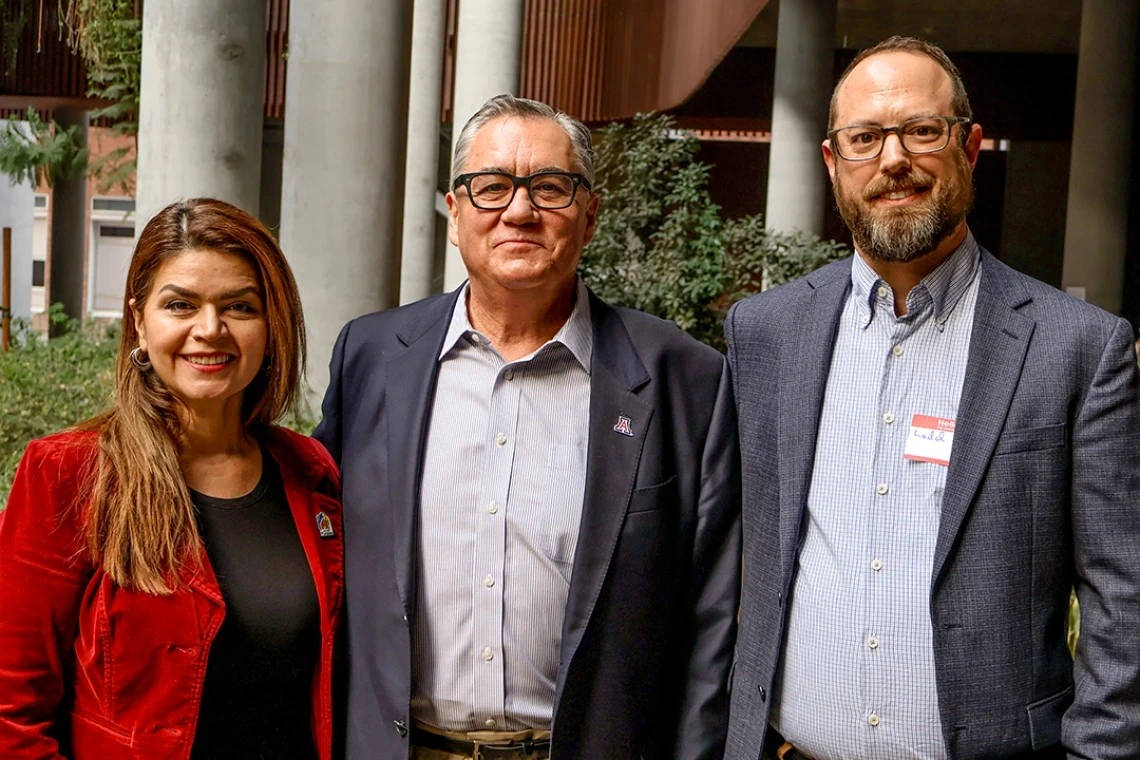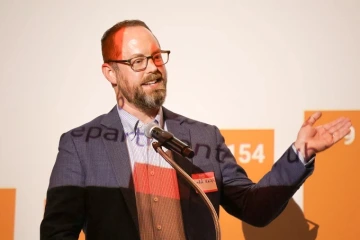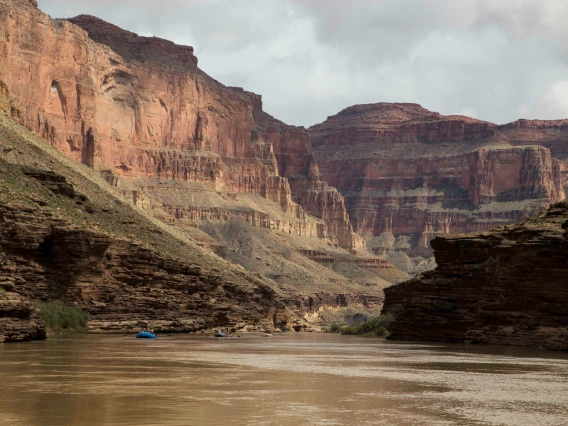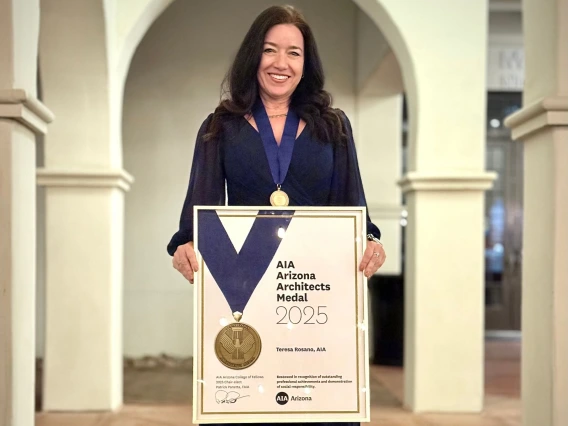Extreme Heat Planning Works: Building on a Proven Platform at the Second Annual Southern Arizona Heat Summit
Planning for extreme heat is key to protecting Arizona communities. This year’s Southern Arizona Heat Summit built on the inaugural program with help from community members, leaders, and experts who participated in the day-long workshop.

From left, City of Tucson Mayor Regina Romero, U of A Senior Vice President of Research and Innovation Tómas Díaz de la Rubia, and U of A extreme heat governance expert Ladd Keith.
Originally published by the Udall Center for Studies in Public Policy
Surrounded by hanging plants, pipes for rainwater collection, metal fins that passively diffuse heat, and stirred by a cool winter breeze, attendees gathered for the second annual Southern Arizona Heat Summit at the U of A’s award-winning ENR2 building on Saturday, February 1, 2025.
Hosted jointly by the City of Tucson, Pima County, and the University of Arizona, the event began with an hour of expert and official presentations on the risks and impacts of extreme heat, as well as the steps taken to protect community members from extreme heat events in southern Arizona.
Speakers during the morning session included Tucson Mayor Regina Romero, Pima County Public Health Director Theresa Cullen, U of A Senior Vice President of Research and Innovation Tómas Díaz de la Rubia, U of A extreme heat governance expert Ladd Keith, and others.
After the opening remarks, attendees broke off into smaller groups dedicated to moving the conversation on heat preparedness in southern Arizona forward on five individual fronts: the built environment, energy and the grid, public health and healthcare, community and neighborhood level action, and workforce and heat protection.
As in the previous year, the findings from those sessions will be shared with officials at the City of Tucson, Pima County, and Arizona Governor Katie Hobbs’ office to help inform efforts to address extreme heat this summer across the state.
Setting an International Example for Extreme Heat Governance

Ladd Keith, associate professor of planning, addresses attendees of the 2nd Annual Southern Arizona Heat Summit held in early February. Keith leads the Heat Resilience Initiative, which is funded by the Technology and Research Initiative Fund - Water, Environmental and Energy Solutions, administered by the U of A's Office of Research, Innovation and Impact, and housed within the Udall Center.
“It’s no accident that Tucson is a leader in climate and heat resilience,” said Mayor Regina Romero at the 2025 Summit.
It’s true that the leadership status of southern Arizonans in heat governance research has been hard earned. And the relatively rapid adoption and implementation of heat mitigation and management policies and practices here in the Sonoran Desert region is a direct result of the diligent work of local officials and experts.
As Keith often notes while presenting about his research, heat is the most deadly weather phenomenon in the U.S. And, as global temperatures continue to rise, the threats posed to human beings by extreme heat will inevitably increase, as well.
It’s for this reason that United Nations Secretary-General António Guterres issued an international Call to Action on Extreme Heat in July 2024 saying, “Extreme heat is having an extreme impact on people and (the) planet. The world must rise to the challenge of rising temperatures.”
In response to that call, the World Meteorological Organization, the UN Office for Disaster Risk Reduction, and the Global Heat Health Information Network (GHHIN) – of which Keith is a Management Committee member – organized a “technical consultation” of global heat and policy experts in Geneva, Switzerland in December 2024 with the aim of “strengthening (international) governance structures that can effectively manage heat risks today and in the future,” according to a summary report published on the GHHIN website.
As Keith puts it, “This is the beginning of creating a global governance framework for extreme heat.”
Less than four years prior, Keith offered an early definition for “heat governance” in a 2021 comment paper published in the journal Nature, which he says was used as the working definition of the term at the Geneva meeting.
“We’re only four years out from that paper,” Keith says of the acceleration of heat governance preparedness in recent years, “... and just last year the United States released a report on a maturity model for heat governance and now the UN is taking it up… so that’s a really good sign.”
As a life-long Tucsonan, Keith has an intimate knowledge of what it takes to survive in one of the hottest climates on the planet. And, as a heat researcher who previously held the title of City of Tucson Planning Commissioner, it’s little surprise that partnerships forged under his leadership have set an international example for what effective heat mitigation and management planning looks like.
Planning Matters: Lessons in Heat Governance
According to the City of Tucson’s Chief Resilience Officer, Fatima Luna, the idea for the first Southern Arizona Heat Summit came to her in October 2023 when she realized that she was one of only a handful of southern Arizona representatives at the 2023 statewide Heat Summit in Tempe.
Upon returning home from that meeting, Luna began working with Keith and other experts to plan the first Southern Arizona Heat Summit at the U of A. “And what happened?” asked Luna before answering her own rhetorical question, “We didn't just host a summit. We took action. Summit recommendations were shared with the governor's office… to develop the heat action roadmap, the Pima County Health Department created the heat preparedness strategy, and the event was a huge success.”
And, Luna added, “the state has been listening.” She noted the presence of Arizona’s first state Chief Heat Officer Eugene Livar, who was appointed to his position in April 2024, just two months after the first Southern Arizona Heat Summit. Mayor Romero and the Tucson City Council also passed their award-winning Heat Action Roadmap and Heat Worker Protection Ordinance in June of the same year and immediately began distributing more than 900 heat relief kits to individuals experiencing houselessness or living in mobile homes.
Mayor Romero credits the 2024 Southern Arizona Heat Summit with paving the way for the success of Tucson’s heat governance programs. “We were able to move so quickly because our preparation began months and months in advance,” she said, adding, “To be clear, our preparation started here in our first ever Southern Arizona Heat Summit.”
Given this track record for field-leading research and policy on extreme heat governance, and the recent establishment of a new Heat Resilience Initiative at the Arizona Institute for Resilience and physically housed within the Udall Center, Keith and the U of A’s role will likely continue to be pivotal in helping officials protect community members from rising temperatures at the local level, the state level, and beyond. And, with Keith’s research receiving support here at the U of A, Tucson will likely remain at the forefront of this field for the foreseeable future.



